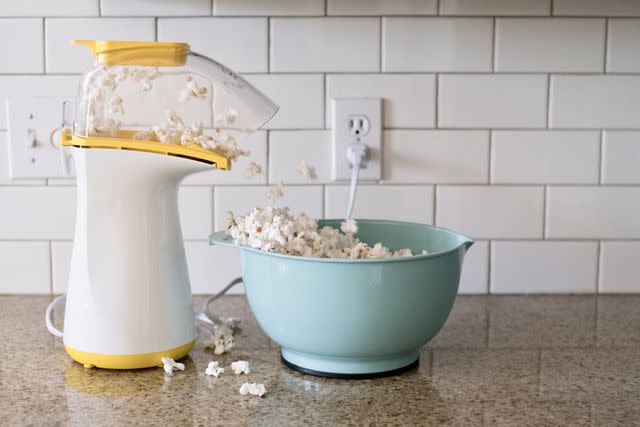Which Way to Make Popcorn Is Healthiest?
Medically reviewed by Melissa Nieves, LND, RD
Popcorn is a corn kernel that puffs up or pops when heated. It’s a favorite snack food and can be prepared in various ways. This low-calorie, high-fiber food is healthy but can quickly become unhealthy if doused in butter and salt.
This article provides an overview of popcorn’s health benefits, its downsides, and how to make it healthy.

Melissa Ross / Getty Images
Benefits of Snacking on Plain Popcorn
Plain, air-popped popcorn is a healthy whole-grain snack. It is packed with nutrients and very low in calories and fat.
Fiber
Popcorn is a high-fiber food. Dietary fiber can be found in plants and is not fully digested by the body. Fiber can be found in popcorn, fruits, vegetables, legumes, whole grains, and seeds.
Most healthcare providers recommend that healthy adults eat 18 to 38 grams of fiber daily. Consuming a fiber-rich diet has been linked with a lower risk of metabolic diseases like obesity, diabetes, and heart disease. Eating fiber-rich foods like popcorn has also been linked to lower cholesterol levels.
However, consuming an excessive amount of fiber has side effects. You may experience diarrhea, bloating, flatulence, and even bowel obstruction.
Antioxidants
Popcorn is rich in a type of antioxidant called polyphenols. Antioxidants are compounds found in plants that reduce cell damage in the body. Polyphenols are linked to better blood circulation and improved digestive health.
Polyphenols can be found in popcorn, fruits, vegetables, nuts, seeds, roots, and whole grains. They protect cells from damage and have been found to slow the development of heart disease and certain types of cancer. Polyphenols also lower inflammation and help regulate the immune system by aiding in producing white blood cells.
Weight Loss
Popcorn is considered a healthy snack option for those looking to lose weight. Research shows that a diet rich in fiber helps maintain a healthy weight. Finding healthy snack options is important when working to lose weight.
One study found that snack foods comprise about one-fourth of adults’ diets in the United States. Popcorn is a low-density food, which means you can eat a large amount without consuming too many calories or too much fat. Popcorn is more satiating (it makes you feel more full) than potato chips. Regularly eating popcorn as a snack is not linked to an increased risk of weight gain.
Popcorn Nutrition Breakdown and Serving Size
Plain, air-popped popcorn is a healthy snack packed with many nutrients. One serving (3 cups) of air-popped popcorn contains just 100 calories and provides one-third of your daily recommended whole grains. Popcorn is one of the five most cost-effective sources of whole grains.
One cup of popcorn contains:
31 calories
1 gram of protein
0.4 grams of fat
6 grams of carbs
1 gram of fiber
Microwave Popcorn
Air-popped popcorn is a healthy snack, but it’s best to avoid microwave popcorn. It is usually high in salt, which raises the risk of high blood pressure (hypertension) and stroke. It also contains chemicals that may be harmful to your health, including:
Diacetyl: A chemical that gives microwave popcorn its buttery taste. Although human studies are still needed, animal studies have found that inhaling diacetyl can cause wheezing and shortness of breath.
Perfluorooctanoic acid (PFOA): It has been linked to attention-deficit hyperactivity disorder (ADHD) and thyroid problems in high doses.
Partially hydrogenated oils: Microwave popcorn usually contains these oils and has been linked with increased heart disease.
What’s a Healthy Salt-Butter-Oil Ratio?
The healthiest way to eat popcorn is plain and air-popped. However, most of us need a little seasoning to enjoy this snack. Because the whole grains in popcorn are so beneficial, don’t undo their benefits by dousing your popcorn in butter and salt.
Once you’ve air-popped your popcorn, add a small drizzle of olive oil and a sprinkling of salt. If you prefer the taste of butter, remember that a little can go a long way. Try melting 1 teaspoon and tossing it with your popcorn. If you still need more flavor, opt for other herbs and spices.
Feeling Health-Conscious? Choose These Types of Popcorn
The healthiest way to enjoy popcorn is to pop it yourself at home. Avoid the processed bags or microwave varieties, as these contain high amounts of salt or sugar, as well as potentially harmful chemicals.
To make your own healthy popcorn at home, use an air popper or the stovetop. To make stovetop popcorn, you’ll need to cook it with oil that can withstand high temperatures, such as canola, coconut, and sunflower.
Once the oil is hot, add a single layer of popcorn kernels to the pan. Cover the pan with a lid, but leave it slightly open to let steam escape and prevent soggy popcorn. Remove the popcorn from the pan as soon as it pops to avoid burning.
You could also cook popcorn kernels in an air popper, bowl, or paper bag.
Salt Swaps and Popcorn Toppers
Now that you’ve popped up a healthy bowl of popcorn, it’s time for the fun part: seasonings. Add a small amount of olive oil or butter if you cooked your popcorn without any oil.
To add serious flavor without the sodium, break out your spice rack. Try rosemary, garlic, paprika, or low-sodium taco seasoning. Try cinnamon or a drizzle of natural peanut butter for a sweet treat.
If you’re missing the processed version of cheese popcorn, try nutritional yeast. This deactivated form of yeast has a nutty, cheesy flavor that is perfect for popcorn. It’s also loaded with vitamins and minerals.
Summary
Popcorn is a healthy, whole-grain snack. Plain, air-popped popcorn is low in fat and calories. It’s also rich in fiber and antioxidants. Popcorn is smart for those looking to lose or maintain a healthy weight.
Avoid adding too much butter, sugar, or salt to your popcorn. Healthier seasonings include olive oil, herbs, spices, nut butter, and nutritional yeast.
Read the original article on Verywell Health.

